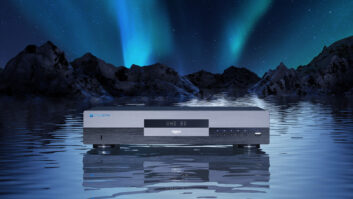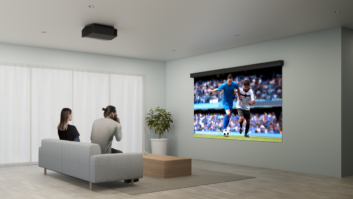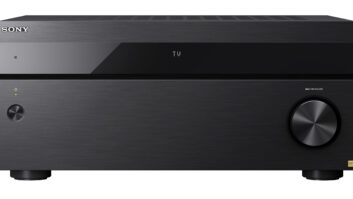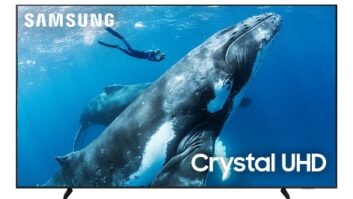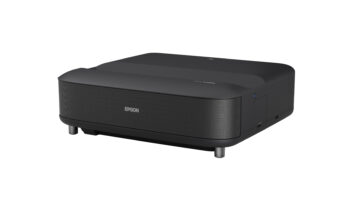Nine more 4K LCD TVs unveiled today by Sony will join a trio of new 4K LCD models introduced at CES as part of the company’s effort to expand its 4K selection and strengthen its HDR (high dynamic range) commitment.
The HDR commitment includes the addition of Dolby Vision HDR for the first time to select models. Sony also plans a firmware upgrade sometime this year to add hybrid log gamma (HLG) HDR to all 2016 and 2017 4K TVs. HLG is intended for use with future pay-TV and ATSC 3.0 broadcasts.
As with Sony’s 2016 4K TVs, all 2017 4K TVs will feature HDR 10.
The company also announced a suggested $299 price for its first 4K Blu-ray player, which will be in stores in March and will be followed closely by a model targeted exclusively to the custom channel. Sony also confirmed that its second ultra-short-throw (UST) native-4K home theater projector remains on course for April availability at a suggested $24,999. It joins a $50,000 model, which remains in the line.
In audio, Sony released pricing and ship dates for an expanded Extra Bass series of portable Bluetooth speakers but didn’t release pricing and ship dates for new soundbars, including its first Dolby Atmos-equipped sound bar, or a new mid-price core-series AVR, which was introduced at CES with Dolby Atmos and DTS:X.
HDR update: In announcing nine more 4K LCD TVs, Sony said all 2017 4K TVs will feature HDR 10 but that Dolby Vision will come to its 4K lineup for the first time in three LCD models in the previously announced X940E and X930E series. Via a firmware update, Sony will also add Dolby Vision to the currently available three-SKU Z9D flagship series of 4K LCD TVs. The Z9D TVs will remain in the line through the calendar year and are currently priced at $5,499, $8,999, and $59,999 for 65-, 75-, and 100-inch models.

Sony’s $7,499-suggested 75-inch XBR-75X940E features HDR 10 and Dolby Vision but will also get a firmware upgrade to add hybrid log gamma (HLG) HDR upgrade. HDR Remaster delivers more HDR-like images from non-HDR content by looking at each object in an image and processing each object individually.
More 4K Sony TVs will arrive with Dolby Vision sometime later in the year when Sony ships its first three 4K OLED TVs, announced at CES and still unpriced. The OLEDs are positioned directly under the flagship Z9D series, and feature screens that vibrate to deliver stereo sound. The OLEDs also deliver what Sony contends is better contrast and color saturation compared with competing OLEDs, thanks to an X1 Extreme processor that is trickling down from the flagship Z9D series to the OLEDs and to the X940E and X930 E LCD TVs. All of the 4K OLED models will also feature HDR 10.
TV pricing, sizes: All 12 of the new 4K LCD TVs appear in three series from 43 to 75 inches at suggested retails from $999 to $7,499. They’ll be in stores in March to join the three-SKU Z9D series of 4K LCD TVs.
All 4K TVs, including the OLED models, feature the Android TV OS.
Presales of the new LCD TVs start today (February 10) through authorized dealers.
The previously disclosed X940/X930 series consists of the $7,499-suggested 75-inch XBR-75X940E with full-array local dimming and the two X930E models with Slim Backlight Drive+ edge-lit local dimming, said to deliver twice the contrast of their predecessors and 10 times the contrast of conventional edge-lit TVs while keeping the TVs thin. Those two models are priced at $3,299 for a 55-inch model and $3,999 for a 65-inch model.
The four-SKU X900E series consists of a $5,999 75-inch model, a $3,299 65-inch model, a $2,399 55-inch model, and a $1,699 49-inch model.

Sony’s $299-suggested UBP-X800 4K Ultra HD Blu-ray player features multichannel SACD and DVD-Audio playback, HDR 10, 3D Blu-ray and BD-ROM playback, dual HDMI outputs, wireless multiroom audio, and high-res audio playback.
The five-SKU X850E/X800E includes a $4,999 75-inch model and a 65-inch model at $2,499, both with the 850E designation. The three 800E SKUs consist of a 55-inch TV at $1,899, a 49-inch TV at $1,099, and a 43-inch model at $999.
Flagship features: All but the three X800E models feature proprietary Super Bit Mapping (SBM) and HDR Remaster technologies, previously available only in the flagship Z9D series. SBM delivers smoother color gradations in images upscaled to 4K without softening the picture, Sony said. HDR Remaster delivers more HDR-like images from non-HDR content by looking at each object in an image and processing each object individually, the company said.
Via their X1 Extreme processor, all models in the Z9D series, planned A1E OLED series, and the X940E/930E LCD series feature “dual-database processing” to upscale pay-TV broadcasts and video streams to 4K without misinterpreting noise as detail, thus maximizing detail in the upscaled images and not adding gray to blacks and colors.
One database is used to reduce on-screen noise, and the other is used for upscaling. “Each database has tens of thousands of references amassed from Sony’s decades of experience creating content for TV and movies,” a spokesman said.
In the planned OLED TVs, the X1 Extreme processor also minimizes temporary image retention when a bright scene shifts to a darker scene. The processor does so by producing minor pixel shifting not visible to the eye, Sony explained. The processor also makes Sony’s OLEDs brighter and increases color saturation compared to the OLED competition, Sony claimed.
4K Blu-ray: The company’s first 4K Blu-ray player hitting the market will be the $299-suggested UBP-X800, in stores in March and followed by the specialist/installer-dedicated UBP-X1000, as yet unpriced.
Both models feature multichannel SACD and DVD-Audio playback, HDR 10, 3D Blu-ray and BD-ROM playback, and dual HDMI outputs, which can be used to send video content to two displays. One HDMI output can also be used to send audio to AVRs whose older HDMI inputs and outputs don’t pass through 4K or HDR content to a display. Information on whether it could be upgraded to add Dolby Vision was unavailable.
Both also feature Wi-Fi, wireless multiroom audio technology, streaming 4K video services, and ability to play high-res audio from USB sources up to 192kHz/24 bits and, with a firmware upgrade, DSD 11.2MHz (DSD 256).
The players’ proprietary HDR-to-SDR conversion maps content to the display capabilities of non-HDR 4K TVs, delivering a wider dynamic range and color volume than competing 4K players that simply strip HDR metadata from a video stream, the company said. The players also let consumers adjust the level of conversion.
Via standard HDMI EDID (Extended Display Identification Data), both players enable the display of a 4K disc on a 1080p display, the company added.
Integrated Bluetooth streams audio to Bluetooth headphones.
Through June 30, purchasers are eligible to receive two 4K Ultra HD discs from Sony Pictures Home Entertainment, including recently released titles.
The installer-focused 4K player will add optional rack-mount ears, RS-232, and IP control for integration with major home-control systems, including Control 4, Crestron, Universal, Savant, AMX, and others. The Ci model also adds a web app, which enables programming via a PC or tablet, and integration with ihiji, the cloud-based network-management service used by custom installers for remote maintenance.
UST 4K laser projector: The VPL-VZ1000ES native-4K UST projector, due in April at a suggested $24,999, and the current $50,000 VPL-GTZ1 model are also targeted to installers. Both ES-series models are positioned as bright enough for use in living rooms, not just darkened home theater rooms, giving more consumers the option of viewing images larger than what most flat-panel TVs can deliver, said product marketing manager Andre Floyd.
The UST projectors are also positioned as delivering a large image in small rooms, in locations with high ceilings and, because they can be used with screens that drop down from the ceiling, in rooms with many windows.
The new model projects pictures between 80 and 120 inches, whereas the current model delivers 60- to 147-inch pictures.
The latest model is also 25 percent brighter at 2,500 lumens, adds HDR 10 and HLG HDR, and adds electronics lens shifting. The latter lets users move the image up or down by up to 6 percent so they don’t have to physically raise the entire projector to reach the bottom of a projection screen. The image can also be shifted horizontally by up to 3 percent.
The new model, at 36.4 by 19.5 by 8.7 inches, is 40 percent smaller than the current model, thanks in part to a shorter light path and smaller lens.
The new model must be placed between 2 and 10 inches from a screen or wall, while the current model can be placed between 0 and 7 inches from a wall or screen. Both models deliver a 179-degree viewing angle, and both can be ceiling-mounted.
For the VPL-VZ1000ES, Salamander is developing a floor-standing cabinet with a recess into which the projector can be placed and mounted flush with the cabinet top. The cabinet also features locations for a center-channel speaker and AV components.
